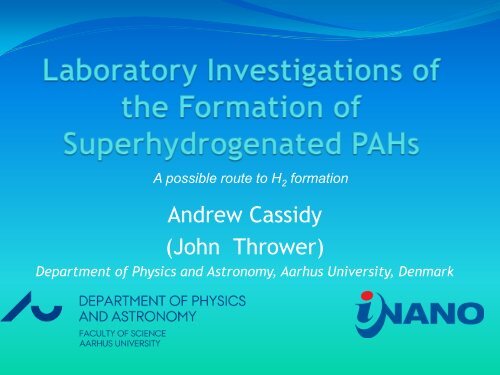Superhydrogenated PAHs: Catalytic formation of H2
Superhydrogenated PAHs: Catalytic formation of H2
Superhydrogenated PAHs: Catalytic formation of H2
- No tags were found...
You also want an ePaper? Increase the reach of your titles
YUMPU automatically turns print PDFs into web optimized ePapers that Google loves.
A possible route to H 2 <strong>formation</strong>Andrew Cassidy(John Thrower)Department <strong>of</strong> Physics and Astronomy, Aarhus University, Denmark
<strong>Superhydrogenated</strong> <strong>PAHs</strong>• Evidence in IR emission• C-H stretching mode• 3.3 μm – aromatic• 3.4 μm – aliphatic• High UV flux (Orion bar)• Limited excess hydrogen• Low UV flux (IRAS 05341)• Significant excesshydrogen• -CH 3 or -HM. P. Bernstein, et al., ApJ, 472, L127 (1996).
Hydrogenation <strong>of</strong> Coronene• DFT Calculations• Addition <strong>of</strong> 1 st H• Outer edge site• Small barrier• Graphite -> 200 meV• Strongly bound• Graphite -> 700 meV• Lower gastemperatures viable60 meV-1.4 eVC 24 H 13C 24 H 12 + HE. Rauls & L. Hornekær, Astrophys. J., 679, 531 (2008).
H 2 <strong>formation</strong> via abstraction• DFT Calculations• Barrierless addition <strong>of</strong> 2 ndH• Large binding energy• Barrierless H abstractionby 2 nd H• H 2 <strong>formation</strong>• Competition betweenabsraction and addition(low/vanishing barriers)• Higher degrees <strong>of</strong>hydrogenation, includingcenter sites, als<strong>of</strong>avourable
Experimental arrangement
TPD: C 24 H 12 from graphite• Graphite (HOPG) exposedto C 24 H 12• Thermal desorption @ 1K/s• Monitor m/z=300 (parention)• Resolve mono- andmultilayers• Multilayers consistentwith previous study †• Desorption energy ca. 1.5eV †R. Zacharia, et al., Phys. Rev. B, 69, 155406 (2004).
Hydrogenation <strong>of</strong> CoroneneCoronene TPDCoronene exposed to 5 min Dφ=10 16 D atoms cm -2Evidence for hydrogenation <strong>of</strong>coronene through detection <strong>of</strong> C 24 H x D y
Hydrogenation <strong>of</strong> Coronene• Hydrogenated coronenedesorbs at slightlylower temperature• Cf. C 6 H 12 desorbing atlower temperature thanC 6 H 6††M. Xi, et al., J. Vac. Sci. Technol. B, 10, 2440 (1992).
Hydrogenation <strong>of</strong> Coronene• Mass spectra <strong>of</strong> desorbedspecies• Integrated over TPD peak• Expected fragmentation /isotope peaks for coroneneCoronene
Hydrogenation <strong>of</strong> Coronene• Mass spectra <strong>of</strong> desorbedspecies• Integrated over TPD peak• Expected fragmentation /isotope peaks for coronene• Exposure to atomic D• Clear evidence forsuperhydrogenated species• Simultaneous loss <strong>of</strong>parent coroneneCoroneneCoronene exposed to 5 min D
Decay <strong>of</strong> Coronene Yield• Significant loss <strong>of</strong> coronene• Single layer• Efficient hydrogenation• σ=0.4 Å 2 300exp( )C A m
Hydrogenation <strong>of</strong> Coronene• Long exposure times• Extensive hydrogenation• Dominated by high m/zCoronene exposed to 180 min D• Close to limiting case(m/z=360)Perhydrocoronene
Hydrogenation <strong>of</strong> Coronene• Long exposure times• Close to limiting case(m/z=360)• Above m/z=336confirms hydrogenation<strong>of</strong> center sites
Hydrogenation: STM imagesCoroneneSubstrate: Cu(100)70 x 70 Å
Hydrogenation: STM imagesCoroneneCoronene exposed to DSubstrate: Cu(100)70 x 70 Å
Hydrogenation <strong>of</strong> Coronene• Long exposure times• Close to limiting case(m/z=360)• Above m/z=336 confirmshydrogenation <strong>of</strong>center sites• Above m/z=348 requiresH-D exchange• Implies abstractionreactions• => HD (H 2 <strong>formation</strong>)
Thank you for your attention
Interstellar H 2 <strong>formation</strong>• The “well-known”problem
Interstellar H 2 <strong>formation</strong>• The “well-known”problem• Surface reactions• Low T• Physisorption on icesurfaces~30 K
Interstellar H 2 <strong>formation</strong>• The “well-known”problem• Surface reactions• Low T• Physisorption on icesurfaces• High T• Chemisorption oncarbonaceous surfaces~30 K
Interstellar H 2 <strong>formation</strong>• The “well-known”problem• Surface reactions• Low T• Physisorption on icesurfaces• High T• Chemisorption oncarbonaceous surfaces• Intermediate T• PAHS?~30 K
Conclusions• DFT calculations and experimental observations:• Show efficient superhydrogenation (includingcenter sites) <strong>of</strong> coronene• Indirect evidence for HD (H 2 ) <strong>formation</strong> throughabstraction reactions
Conclusions• DFT calculations indicate efficientsuperhydrogenation <strong>of</strong> coronene• Experimental observation <strong>of</strong> superhydrogenatedcoronene• Clear evidence for extensive hydrogenation• Indirect evidence for HD (H 2 ) <strong>formation</strong> throughabstraction reactions3.12 3.31 3.64See posters by Andrew Cassidy, Emil Friis and Vito MennellaSTM TPD IR
STM parameters (Cu)• Coronene• V t =-3500 mV• I t =-0.1 nA• Coronene exposed to D• V t =-1900 mV• I t =-0.2 nA
Thermal desorption (TPD)ThermocoupleAmplifierControllerPCQMS Signal desorption rateExpose to Coronene to D - Hot (~2100 K)
Experimental arrangement
Interstellar <strong>PAHs</strong>• High UV flux• Small <strong>PAHs</strong> dissociated• Intermediate UV flux• Dehydrogenation• IonizationLow UV flux• Higher hydrogenationstates for large <strong>PAHs</strong>stablePAHhProductsPAH h Product HPAH h PAH ePAH H HPAHV. Le Page, et al., ApJSS, 132, 233 (2001).
Hydrogenation: STM imagesCoroneneSubstrate: HOPG200 x 200 Å
Hydrogenation: STM imagesCoroneneCoronene exposed to DSubstrate: HOPG200 x 200 Å
Hydrogenation: STM imagesCoroneneCoronene exposed to DSubstrate: Cu(100)70 x 70 Å
















